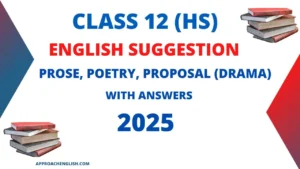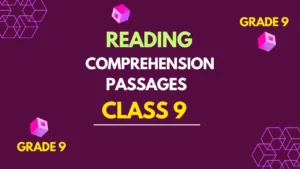Punctuation Marks Class 6 plays a crucial role in the English language by helping to clarify meaning, organize written language, and indicate pauses and emphasis.
This article will comprehensively overview Punctuation Marks Class 6 with Rules, Examples, and Exercises.
Punctuation Marks for Class 6 Definition and Types
Punctuation Marks in English grammar means using a system of symbols like commas, full stops, question marks, exclamation points, quotation marks, apostrophes, hyphens, semicolons, colons, etc. These symbols help organize writing, clarify the meaning, and show where to pause, emphasize, or change tone.
English Grammar Ebook for Class 6
Some of the most commonly used punctuation marks in English Grammar are as follows:
- Capital Letters
- Full Stop (.)
- Comma (,)
- Question Mark (?)
- Exclamation Mark (!)
- Quotation Marks (“…”)
- Apostrophe (‘)
- Hyphen (-)
- Semicolon (;)
- Colon (:)
A. Punctuation Marks Class 6 of Capital Letters
Marks of punctuation like capital letters make our writing clearer and easier to understand.
Capital letters are used –
1. to begin a new sentence.
For example,
- Our school reopens on 2 July.
- Do you know the way to the mall?
2. for names of people and titles.
For example,
- President of the United States, Joe Biden and Prime Minister Narendra Modi addressed the press jointly.
- I haven’t met Ravi or Kunal today.
3. for the pronoun I.
For example,
- Meera and I went to the fair.
- Yesterday, I planted a mango sapling in my garden.
4. for titles of literary works, novels, and films.
For example,
- Gitanjali is a collection of poems by Rabindranath Tagore.
- Have you read the novel Nicholas Nickleby?
5. for names of months of the year and days of the week.
For example,
- I will meet you on Monday.
- Her birthday is in July.
6. for names of festivals and important holidays.
For example.
- Easter, Bihu, Navroze, and Holi are spring festivals.
- We celebrate Independence Day on 15 August.
7. for names of countries, continents, states, regions, cities, towns and villages.
For example,
- The Malabar region is the area between the Western Ghats and the Arabian Sea.
- New Delhi is the capital of India.
8. for names of rivers, oceans, seas, and lakes.
For example,
- The Indian Ocean is the third largest ocean in the world.
- A number of large rivers flow into the Bay of Bengal.
9. for names of mountain ranges, mountains, deserts, and other geographical formations.
For example,
- The Himalayas are home to many of the world’s highest mountains. Famous peaks include Everest, Karakoram, Kailash, Kanchenjunga, Nanga Parbat, Annapurna, and Manaslu.
- The Siachen Glacier is the largest glacier outside the poles.
10. for adjectives derived from proper nouns.
For example,
- I love Italian cheese.
- He is studying English literature at the university.
11. for names of languages and nationalities.
For example,
- The French are proud of their heritage.
- Rajiv can speak Chinese.
12. for names of streets, buildings, museums, and art galleries.
For example,
- 1 stay at 10, Cherry Blossom Street.
- The Taj Mahal is one of the seven wonders of the world.
13. for the first letter of every new line of a poem.
For example,
Rise, brothers, rise; the wakening skies pray to the morning light,
The wind lies asleep in the arms of the dawn like a child who has cried all night.
Come, let us gather our nets from the shore and set our catamarans free,
To capture the leaping wealth of the tide, for we are the kings of the sea!
14. for names of ships, trains, and spacecraft.
For example,
- Since 24 September 2014, Mangalyaan has been orbiting Mars.
- On 15 April 1912, the Titanic sank after colliding with an iceberg.
15. for abbreviations.
For example,
- ISRO (Indian Space Research Organisation)
- WHO (World Health Organisation)
B. Full Stop (.) Rules for Punctuation Marks Class 6
A full stop is used
1. at the end of assertive and imperative sentences.
For example,
- Bengaluru is referred to as the Silicon Valley of India. (assertive sentence)
- Read the newspaper every day to keep yourself informed. (imperative sentence)
2. after some abbreviations.
For example,
- The interview will be between 11 a.m. and 1 p.m.
Note: In British English, many abbreviations do not require a full stop. For example, Dr, Mr, Mrs, MA, PT Usha, etc
C. The Comma (,) Punctuation Marks Class 6
A comma is used
1. to separate words in a list.
For example,
- He likes to play football, hockey, cricket, tennis and basketball.
2. to separate phrases or clauses in a sentence.
For example,
- A car, without a number plate, was parked outside the police station.
- We met at the mall, had lunch, and afterwards went to meet Raghav.
3 to separate adjectives in a list.
For example,
- Riddhima is young, beautiful and intelligent.
4. to set off names from the rest of the sentence.
For example,
- Gayatri, can you open the window?
- Mayank, please help the other students.
5. to set off words like yes, no, please, well, of course.
For example,
- Yes, we have won the match.
- Well, he may come over by evening.
6. before or after direct speech.
For example,
- He said, ‘I lived in Mathura in the 90s.”
- I will bring the groceries in the evening,” said Prakash.
7. before a coordinating conjunction.
For example,
- The directions to the new school are complicated, but I’ll soon understand them.
- I had completed my homework, so Mother let me go outside to play.
8. to separate an introductory word or phrase in a sentence.
For example,
- In 1939, the Second World War began.
- Fortunately, he too arrived late.
9. before a tag question.
For example,
- The stories by Premchand are very interesting, aren’t they?
- President Kalam was a great man, wasn’t he?
D. Question Mark (?) Rules for Class 6 Punctuation Marks
A question mark is used
1. at the end of every direct question.
For example,
- In which year did Rakesh Sharma go into space?
- Do you think we need to do more for our environment?
2. at the end of a tag question.
For example,
- Football is your favourite game, isn’t it?
- You are late, aren’t you?
E. Exclamation Mark (!) Rules for Class 6 Punctuation Marks
The exclamation mark is used
1. at the end of an exclamatory sentence.
For example,
- What delicious food they served us!
2. after an interjection.
For example,
- Ouch! You stepped on my feet.
F. Quotation Marks (‘…’) Rules for Class 6 Punctuation Marks
The quotation marks, or the inverted commas, are used
1. to show the exact words of the speaker.
For example,
- ‘You have done India proud,’ said the manager to the members of the winning team.
- When Neil Armstrong set foot on the moon, he said, “That’s one small step for a man, one giant leap for mankind!”
Note: We use double quotes for quotations within quotations.
For example, Daljeet said, 1 was “kidnapped” by an alien.”
2. to highlight names of short plays and short stories.
For example,
- “The Ugly Duckling” was written by Hans Christian Andersen
- Shakespeare wrote many comedies like “Much Ado About Nothing”, “The Comedy of Errors”, “The Taming of the Shrew” and “As You Like It.”
G. Apostrophe (‘) Rules for Class 6 Punctuation Marks
The apostrophe is used
1. to show possession or belonging.
For example,
- This is Annie’s book.
- One should choose one’s words carefully.
- The girls’ bags were lost.
2. to indicate missing letters in words.
For example,
- We can’t go out now.
- Don’t talk so loudly.
H. Hyphen (-) Rules for Class 6 Punctuation Marks
The hyphen is used
1. to make a compound adjective.
For example,
- a green-eyed monster
- a well-known actor
2. to make a compound noun.
For example,
- sister-in-law
- passer-by
3. to form a compound word from a prefix and a proper noun or a common noun.
For example,
- There were many great leaders in pre-Independent India
- I am sure they will play well in the post-lunch session.
4 when writing compound numbers between 21 and 99.
For example,
- thirty-three, sixty-five, eighty-nine
5. after certain prefixes, such as, ex, self, all, anti.
For example,
- ex-husband
- self-control
- all-inclusive
- anti-social
I. Semicolon (;) Rules for Class 6 Punctuation Marks
The semicolon indicates a longer pause than the comma. A semicolon is used
1. to separate two clauses in a sentence that are not joined by a conjunction.
For example,
- There are dark clouds in the sky; it will be foolish to go for a walk now.
- We went to bed early; no one wanted to stay up! late.
2. instead of, a comma, separate parts of a sentence that already contain commas.
For example,
- The Supreme Court has banned the bursting of noisy firewood, crackers and
- bombs; they cause sound pollution, car damage and are dangerous too.
- Siddharth, Faiz, and Anthony are friends; they are neighbours too.
J. Colon (:) Rules for Class 6 Punctuation Marks
A colon is used
1. to introduce a list of items.
For example,
- This is what you have to bring for the craft class tomorrow: a sheet of chart paper, sketch pens, a pencil, an eraser, a ruler, tape, a tube of glue and a pair of scissors.
- Louisa M Alcott has written four books about the March sisters. They are: Little Women, Good Wives, Jo’s Boys and Little Men.
2. between two main clauses in cases where the second clause explains or follows from the first.
For example,
- This is the secret of my professional lifes always do your very best.
3 before a quotation, at the beginning of a statement or an explanation, and sometimes before a quotation (direct speech).
For example,
- Today’s headline reads ‘Highways are Death Tracks’.
- Bhagat Singh cried out: ‘Inquilab Zindabad
Remember: Nowadays, the generally accepted rule is to place a comma before starting a direct quotation rather than a colon.
For example,
- Mother Teresa said, ‘Give, till it hurts.’
Class 6 English Grammar Chapter-Wise Contents:
3: Nouns
5: Gender
6: Case
7: Pronouns
8: Verbs
10: Adjectives
12: Adverbs
13: The Simple Tense
17: Prepositions
18: Conjunctions
19: Articles
22: Direct and Indirect Speech
FAQs about Punctuation Marks
What are punctuation marks?
Ans: Punctuation marks are symbols used in writing to enhance clarity and convey meaning.
Why is punctuation important?
Ans: Proper punctuation helps to avoid confusion and ensures that the reader understands the intended meaning of the text.
How can I improve my punctuation skills?
Ans: Practice using punctuation marks correctly in your writing and review the rules regularly.
What happens if I don’t use punctuation correctly?
Ans: Incorrect punctuation can lead to misunderstandings and make your writing difficult to read.
What are the 10 examples of punctuation with answers?
Ans: Here are ten examples of punctuation marks along with brief explanations:
1. Period (.): Used to end declarative sentences or statements.
Example: She went to the store.
2 Comma (,): Used to separate items in a list, clauses in a sentence, or to provide pauses.
Example: I need to buy eggs, milk, and bread.
3. Question Mark (?): Used at the end of a sentence to indicate a question.
Example: What time is the meeting?
4. Exclamation Point (!): Used to express strong emotions or emphasis.
Example: Wow! That’s amazing!
5. Colon (:): Used to introduce a list or to join sentences where the second explains or follows from the first.
Example: There are three things I love: reading, writing, and hiking.
6. Semicolon (;): Used to separate closely related independent clauses not joined by a conjunction.
Example: She loves to hike; she often goes on long trails.
7. Quotation Marks (” “): Used to indicate direct speech or to enclose the titles of short works.
Example: “I’ll be there at 5,” she said.
8. Apostrophe (‘): Used to indicate possession or to show the omission of letters in a contraction.
Example: The dog’s bone was buried in the backyard.
9. Hyphen (-): Used to join words together, indicate word breaks at the end of a line, or to form compound words.
Example: Well-known author; self-esteem.
10. Ellipsis (…): Used to indicate the omission of words in a text or a pause in speech.
Example: “I thought you said… never mind.”
Punctuation Marks Class 6 Exercises
Practice punctuation with fun exercises designed for Class 6 students, improving their English skills effectively.
A. Look at the given example. Use apostrophe in these sentences to show possession.
For example,
➖ the house owned by Prerna
Prerna’s house
1. the bone of the dog
2. the address of Feroze
3. the library owned by India Foundation
4. the bungalow owned by the Sharma family
5. the phone owned by Niharika
6. the photograph of my mother
7. the largest state of India
8. the first law of Newton
9. the car owned by our neighbour
10. the scooter owned by our teacher
B. Place the apostrophes wherever required.
1. I put my class teachers books in the cupboard.
2. Nagmas clothes are always neat and tidy.
3. The cats whiskers are covered in milk.
4. Why did he leave Julius house so early?
5. Nikhil borrowed Dhonis cricket bat.
6. Souravs pizza looks very tasty.
7. I found my parents photographs in an old box.
8. Sonia loves painting on childrens T-shirts.
9. I cant go with you to Rahuls house.
10. Im going to the shopping mall today.
11. Whats his brother-in-laws name?
12. Id like to play with Enas dog but hes so big
18. Dont you know that they are all members of the World Cup winning team?
14. Teachers Day is celebrated in our country on the fifth of September.
16. The Annual Reunion for students of the batches of 78 and 80 has been planned,
C. Rewrite these sentences. Punctuate them correctly using capital letters, full stops, commas, apostrophes, hyphens, colons, semicolons, inverted commas, question marks and exclamation marks, wherever required.
1. We Shall Overcome is the name of my fathers favourite song
2. bugs bunnys favourite line is whats up doc
3. never I dont believe it
4. last year our neighbours cats ran away
5. please pass me the bowls that are on the table said the lady
6. pope francis the leader of the roman catholic church didnt want to live in a big house
7. theres a fire in the building run shouted the night guard
8. youve been here before havent you
9. lawyers have 11 b written after their names
10. the boys shouted hurrah weve won the match
11. the rafflesia plant has the largest flower on earth
12. oh no weve missed the train
13. many players have captained the indian cricket team they include bedi gavaskar kapil dev tendulkar Dravid Ganguly and dhoni
14. nita kumar our class teachers sister took us to an old age home
15. raj kumar hirani has made two munna bhai movies they are munna bhai mbbs and lage raho munna bhai







